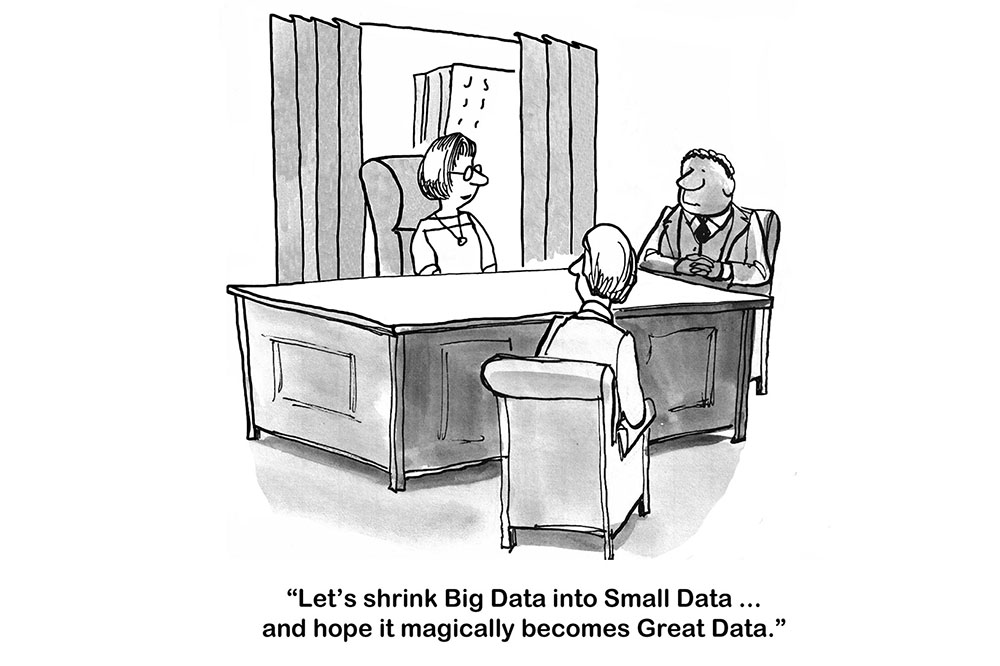Many companies are looking for a systematic methodology to apply technology to digitize and improve existing business processes. 4R, from Results to Root Causes to Remediation to Rhythm, is a proven way to identify process improvement opportunities, apply technology to optimize processes, and ensure impact out of the investment.
Many approaches have been taken in the past to reengineer business processes. Examples would include Six Sigma’s DMAIC, Business Process Reengineering (BPR), etc. Most of these approaches were created before the arrival of the current wave of technologies, Big Data and Advanced Analytics, and agile development methodology. Given that computing technology used to be difficult to program and took a long time to deliver, manual workarounds such as statistical sampling were often used to get around the lack of the data and slow speed to get IT systems done to deploy business process changes.
With new application development methodologies such as Agile, with instantly-deployable technologies such as Cloud, and with Big Data and Advanced Analytics and Artificial Intelligence, companies now have many more weapons to digitize business processes. But how do we know which processes to improve? How do we make sure that the technology investment will result in concrete business outputs?
The questions of picking business processes to digitize are easier for industries and companies that are facing significant customer behavior changes, e.g., banking, retail, media, and even healthcare. With customers moving online and demanding the same sophistication and intuitiveness as Apple and Google and Amazon have been delivering, these consumer-facing industries and companies in the industries don’t have a choice – they must react and digitize, or they would face the same fate as Blockbusters.
However, a lot of other industries don’t have the same level of consumer interaction. For B2B companies or companies that are in manufacturing spaces, sometimes it is difficult to identify opportunities to digitize the business processes. Most such companies have processes in place already and core systems such as ERP are performing as designed. How should such companies pick new processes to improve and digitize?
Over the last couple of years, I have worked with a number of clients on digitizing business processes. I have created a methodology called 4R – Results->Root Causes->Remediation->Rhythm to allow companies to use technology to reimagine and reengineer their business processes, while ensuring that the technology investment creates intended impact.
The methodology starts with identifying opportunities and business process candidates to reengineer. Companies can start with the Results, the metrics and the business KPIs that significantly impact business outcomes, across revenue, cost, and compliance. Examples can be No. of Products per customer, customer attrition ratios, and Days on Hand for inventory. The good news is that every company will have opportunities to improve themselves and there is an unlimited supply of Results metrics that can be further improved. Companies can benchmark themselves against their competitors to identify opportunities. Or they can simply benchmark individual units such as geographies or product lines or customer segments to identify opportunities to reduce the performance variances for the same metric and improve overall companywide performance. For example, for retailers, we can compare the store performances. For insurance companies, we can compare the sales performance across geographies and product segments.
Once the Results metric(s) is identified, companies can shift into the core levers that impact the Results metric(s) and identify the Root Causes on why the Results metrics are the way they are today. Root causes are the underlying issues that drive the movement of the Results metrics. For example, Number of Products per customer can be low because companies don’t have quality customer data. It can be because companies in the past only focused on new customer acquisitions and had under-invested in customer retention and cross selling. Similarly, if we look at inventory and days on hand, it could be caused by excess inventory driven by dead stocks. Or it could be that we inaccurately forecasted demand and now have parts sitting idle, waiting to be manufactured and distributed
Now that we have identified the issues, we can take actions to remediate them and address the root causes. For example, if a company has historically underinvested in cross selling, the remediation action could be to have sales staff reach out to all existing customers to check in and bring three new products or services to each customer.
Remediation actions must cut across people, process, and technology. While many companies have the tendency to blame the IT systems for their underlying performance issues, the reality is that systems will only behave in the way that they are programmed to do. A common problem of blindly applying technology levers is that companies end up automating bad processes to create even bigger problems. When companies do remediation, they must consider fully the underlying process and people root causes to ensure technology achieves its intended purposes.
From Results to Root Causes to Remediation, the methodology allows companies to be end goal driven and perform technology and process changes that are destined to achieve actual impact. The impact can be quantifiably demonstrated by the movement of the Results metrics. However, the process improvement is not static. The sequential movement, from Results to Root Causes to Remediation, must be repeated. This is where the Rhythm comes into play.
Rhythm means that companies must install the underlying infrastructure to continuously identify improvement opportunities and use the process of Results to Root Causes to Remediation to capture the opportunities. There are three key factors to consider in Rhythm. First, companies must ensure there are people who are dedicated to conduct the process improvement activities. Given that many companies have installed process improvement methodologies such as LEAN and Six Sigma before, many of the staff who are conversant in such methodologies can be readily re-deployed to work on the digital process improvement activities now. Second, companies need to integrate process improvement methodologies with regular application development release schedules to ensure IT is well integrated into the process improvement rhythm. Instead of the traditional way of developing requirements for process changes and then turning them over to IT to develop the underlying code, companies should instead integrate business and IT in process improvement activities and have one schedule that cuts across business process changes and IT deployment. Lastly, changes must be made to stick. Digital process improvement, similar to LEAN and Six Sigma, will only work when people are motivated and trained. The good news is that again, because digital process improvement builds on top of the LEAN and Six Sigma, much of the change management activities laid out in those methodologies can be readily adopted here.
The Results->Root Causes->Remediation->Rhythm approach has a number of key advantages:
- It’s Business-Back, not Technology Forward. Instead of using technology as a hammer looking for a nail, the 4R methodology is driven back from the specific business problems. The business impact is the top priority from day 1, since the methodology starts with concrete results metrics.
- It’s solution and impact oriented. The goal of 4R is to identify remediation actions that improve business processes and create concrete and quantifiable results. The methodology won’t stop at finding the root causes. It will only finish when the remediation action has been fully installed in live business processes.
- It is simple to understand. Companies can systematically brainstorm and identify root causes that are causing deficient performance in Results. Remediation actions can then be taken to address the root causes. The 4R builds on top of existing process improvement methodologies such as LEAN and Six Sigma.
- It is quantified and measured. The 4R approach centers around quantified metrics. For each layer and action of Results/Root Causes/Remediation, there should be at least one metric to evaluate how effective the current processes and how much room for improvement there is. The quantification of the metrics also allows for benchmarking both internally and externally.
- It allows companies to easily identify opportunities to identify and apply technology to address the issues and improve the results. Automation, analytics, and artificial intelligence can be great technology levers for companies to remediate current root causes. For example, if poor demand forecast is causing excess inventory, companies can potentially leverage AI to create better forecasting algorithms to predict demand.
With the recent rapid technology advances, companies now have many more weapons in hand to make the 4R process faster and repeatable:
- For root causes, it’s now much easier to capture data, integrate data, and use data analytics to identify root causes. As I said at the beginning of the paragraph, in the old days, with the lack of data, companies would use techniques such as surveys and sampling to estimate. These techniques can now be evolved into big data analytics and it’s much quicker and easier to define metrics and gather necessary data to output the actual results. Companies can also incorporate both internal data and external data to better predict future.
- Once the root causes are defined, there is a huge arsenal of technology weapons that can be deployed to remediate the root causes. Robotics process automation to remove manual repeating activities, artificial intelligence to simulate human-machine interaction, advanced analytics and machine learning to better predict future and augment human intelligence, those are just some examples.
- To make 4R a repeatable process, rhythm is critical. Current software development methodologies such as agile and sprint can be readily leveraged and integrated into business process improvement activities.
For a healthcare client, my team and I took the 4R approach to address the inventory management processes. We focused on the Results – Days on Hand, which is the single largest cost item for the company’s P&L. After brainstorming sessions and systematic process reviews, we identified 7 core areas and 40 or so root causes on why the Days on Hand for the company has significant improvement opportunities. The 40 root causes were translated into 40 remediation actions and projects. A single KPI was assigned to each root cause and associated remediation action. This way the company can easily track the progress made by the various improvement actions.
For many companies who don’t have direct consumer facing activities, 4R can be a great methodology to identify opportunities to digitally improve existing business processes. 4R leverages a lot of the thinking from LEAN and Six Sigma, toolkits that companies are already familiar with. Good luck experimenting with this!



